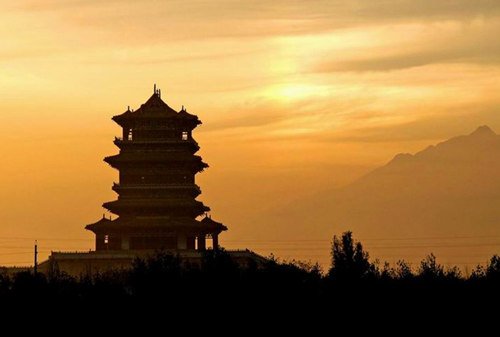Chinese poem - “On the Stork Tower" By Wang Zhihuan (Includes original song and video) | 《登鸛雀樓》 - 王之渙 (內有原創樂曲及影片)
The Background 創作背景
Wang was a scholar in the Tang dynasty and passed the Imperial exams at a very young age. He went on to become an official for the Emperor, but then lost his job when he was set up by some people who wanted him out of the way.. All this happened when Wang was still in his twenties. After losing his job, Wang became a nomad. He wrote “On the Stork Tower” when he was only 35, and it is one of the few great poems by him. The stork tower is located at Shanxi province in China, and said to have got its name due to the many storks that fly around here. It is believed that Wang climbed up to the tower, looked at the majestic surrounding scenery, and still felt the passion within him. He wrote this poem to reflect his enthusiasm and desire to continue to move upwards and forwards.
唐代詩人王之渙早年及第,曾任冀望州衡水县的主薄,不久卻因遭小人誣陷被罷職。二十多歲的他,從此便踏上了漫遊訪友的生活。流傳千古的《登鸛雀樓》是王之涣僅存的幾首絕句之一,而作者在寫這首詩時年僅三十五歲。鸛雀樓舊址在山西永濟,傳說常有鸛雀在此停留,故得此名。作者應是登上此樓,目睹壯麗的祖國河山,心中的抱負油然而生,便藉此詩表達積極進取的精神。
The meaning of the poem 作品大意

白日依山盡,黃河入海流。
Bái rì yī shān jìn , Huáng Hé rù hǎi liú
欲窮千里目,更上一層樓。
Yù qióng qiān lǐ mù , gēng shàng yī céng lóu
The sunset gradually lowers behind the range of mountains
夕陽依傍著山巒落下,
The Yellow River gushes towards the sea
黃河向著大海奔流。
If you want to see better views
若想看盡千里風景,
Then you have to ascend up higher
便要登上更高的一層樓。
Highlights 精選詩句

「白日依山盡,黃河入海流」
Bái rì yī shān jìn , Huáng Hé rù hǎi liú 。
In the poem Wang uses the colour white to describe the sunset. This may seem rather odd, but if you think about it, he has climbed high up to the tower, so all he can see is the sunset shrouded by the clouds. Thus the sunset he sees is not the normal bright golden orange colour. In the second line of the poem, he is imagining the Yellow River gushing into the sea. From the Stork Tower, he can’t see the Yellow River so he is taking readers on an imaginative journey with words. These two line consists of 10 words only, yet Wang has used colour (white, yellow), scene (mountain, river, sea), height (mountain, sea) and tempo (sunset, gushing river) very creatively in his writing.
作者用短短十個字,便把一副雄偉壯麗的景色呈現在讀者眼前。作者首先從色彩著手:用「白」來形容夕陽。這並不常見,甚至似乎有欠妥當。但轉念一想,作者登高遠眺,看到的可能正是雲遮霧障的落日,它的餘暉在山巒和雲彩的遮擋下變得更加黯淡,所以作者的「白」字用得巧妙。上句是作者親眼所見,下句則融入了作者的想像。樓前的黃河咆哮而過,最終「奔流到海不復回」(語自李白《將進酒》)。作者的位置不應看到黃河入海,但他用極有限的字句引起讀者無限的想像,展現了一副無邊無際、波瀾壯闊的景象,增強了畫面的深度與廣度。短短兩句詩,作者便寫出了日、山、河、海;高、低、緩、急,其寫作功力實在令人讚嘆不已。
Fun Fact 趣味小知識

reference
When the Korean President visited China in 2013, President Xi gifted her with a calligraphy writing of “On the Stork Tower”. Korea said that the poem was a perfect reflection of the Korea-Sino relationship in the past twenty years. The traction of the sunset and energy of the Yellow River was a perfect way to describe the developing relationship, and that they hope the relationship between the two countries could continue to rise to the next level. This is a clear demonstration of the standing of “On the Stork Tower” within the literary world.
2013年韓國總統訪華時,習近平主席送了一副《登鸛雀樓》的書法作品給她。韓國表示,中國通過《登鸛雀樓》的詩句,表達了「過去二十年韓中關係的發展仿佛『白日』垂直運行的軌道和横穿曠野的江河一般,壯觀而充滿活力,今後希望兩國以『欲窮千里目,更上一层楼』的心境將韓中關係推上新的台階。」中國國家主席的這一舉動,證明了《登鸛雀樓》在中國詩詞中的地位。
reference

Posted from my blog with SteemPress : http://ccp-hk.vornix.blog/2018/10/05/ccp18/